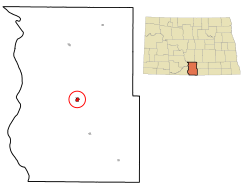Linton, North Dakota | |
|---|---|
 Emmons County Courthouse in Linton – Dedicated, October 6, 1934 on the occasion of the 50th anniversary of Emmons County | |
 Location of Linton, North Dakota | |
| Coordinates: 46°16′07″N100°13′58″W / 46.26861°N 100.23278°W | |
| Country | United States |
| State | North Dakota |
| County | Emmons |
| Founded | 1899 |
| Government | |
| • Mayor | Daniel Imdieke |
| Area | |
• Total | 0.78 sq mi (2.03 km2) |
| • Land | 0.78 sq mi (2.03 km2) |
| • Water | 0 sq mi (0.00 km2) |
| Elevation | 1,722 ft (525 m) |
| Population | |
• Total | 1,071 |
| 1,052 | |
| • Density | 1,364.5/sq mi (526.84/km2) |
| Time zone | UTC-6 (Central (CST)) |
| • Summer (DST) | UTC-5 (CDT) |
| ZIP code | 58552 |
| Area code | 701 |
| FIPS code | 38-46980 |
| GNIS feature ID | 1036132 [2] |
| Highways | US 83, ND 13 |
| Website | lintonnd.org |
Linton is a city in and the county seat of Emmons County, North Dakota, United States. [5] The population was 1,071 at the 2020 census. [3] When compared with the other 356 cities in North Dakota, Linton ranks in the top twelve percent based on the number of its residents. The city serves as a governmental, commercial and business hub for Emmons County.
Contents
- History
- Notable persons from Linton
- The creation of Linton
- Demographics
- 2010 census
- 2000 census
- Education
- Early views of Linton
- Geography and climate
- References
- External links
A nearby historic site listed on the National Register of Historic Places is Sacred Heart Cemetery, Wrought-Iron Cross Site, in or near Linton. [6]












